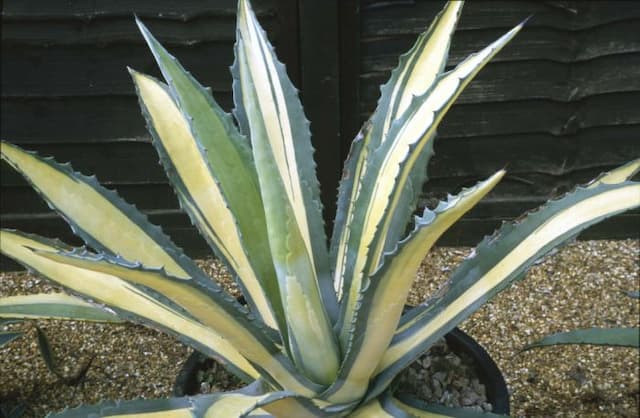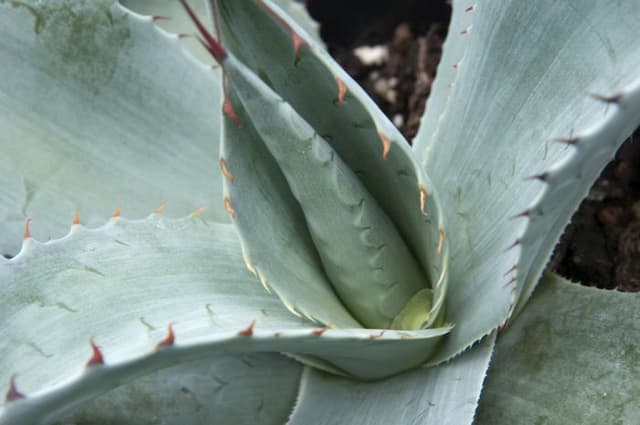Pineapple lily 'Indian Summer' Eucomis comosa 'Indian Summer'

ABOUT
'Indian Summer' is a bulbous perennial to around 50cm tall with dark green, strap-shaped, semi-erect leaves. White, star-shaped flowers flushed with pale pink are borne in dense spikes on sturdy purple stems in summer and topped with a cluster of leaf-like bracts
About this plant
 Names
NamesFamily
Asparagaceae.
Synonyms
Pineapple Lily, Pineapple Flower.
Common names
Eucomis comosa
 Characteristics
CharacteristicsLife cycle
Perennials
Foliage type
Deciduous
Color of leaves
Green
Flower color
Burgundy
Height
1-2 feet (30-60 cm)
Spread
1 foot (30 cm)
Plant type
Bulb
Hardiness zones
7
Native area
South Africa
Benefits
 General Benefits
General Benefits- Aesthetic Appeal: Adds visual interest to gardens with its striking pineapple-like flowers and attractive rosette of strappy leaves.
- Pollinator Attraction: Flowers provide nectar for bees and other pollinators, contributing to the health of the local ecosystem.
- Easy Care: Requires minimal maintenance once established, making it suitable for gardeners of all experience levels.
- Drought Tolerance: Once established, it is relatively drought tolerant, reducing the need for frequent watering.
- Versatility: Can be grown in borders, containers, and as a specimen plant, offering flexibility in garden design.
- Long Blooming: Long flowering period from mid to late summer, providing color and interest for an extended period.
- Suitable for Cutting: Flowers can be used in floral arrangements, adding exotic charm to bouquets.
- Deer Resistance: Usually not favored by deer, which helps prevent damage to the plant in areas where deer are prevalent.
- Seasonal Dynamics: Foliage adds texture to the garden during spring and summer, and dying leaves offer autumnal interest.
 Medical Properties
Medical PropertiesThis plant is not used for medical purposes.
 Air-purifying Qualities
Air-purifying QualitiesThis plant is not specifically known for air purifying qualities.
 Other Uses
Other Uses- Photography subject: With its unique structure and vivid colors, the pineapple lily can serve as an exotic subject for professional and amateur photographers alike.
- Floral art: The distinctive blooms and leaves of the pineapple lily can be used in floral art, such as Ikebana, the Japanese art of flower arrangement.
- Educational model: Botany teachers may use the pineapple lily to illustrate plant parts and pollination strategies to students due to its clear floral architecture.
- Garden border plants: The pineapple lily's compact growth habit makes it ideal for use as an edging plant in garden borders.
- Theme gardens: This plant can be included in themed gardens, such as a tropical or exotic garden, to enhance the overall aesthetic.
- Summer festivals: In areas where summer festivals celebrate local flora, the pineapple lily can be part of displays and competitions.
- Plant dye: Some gardeners use the leaves and flowers to create natural dyes for fabrics, although the colors produced may be subtle and unique.
- Culinary decoration: Pineapple lily flowers can be used as a non-toxic decorative element for gourmet dishes or desserts.
- Eco-friendly confetti: Dried petals of pineapple lily flowers provide an eco-friendly alternative to traditional confetti at events.
- Art inspiration: The form and colors of the pineapple lily can inspire artists to create paintings, drawings, or sculptures.
Interesting Facts
 Feng Shui
Feng ShuiThe Pineapple Lily is not used in Feng Shui practice.
 Zodiac Sign Compitability
Zodiac Sign CompitabilityThe Pineapple Lily is not used in astrology practice.
 Plant Symbolism
Plant Symbolism- Exotic Beauty: Eucomis comosa 'Indian Summer', commonly known as Pineapple Lily, symbolizes exotic beauty due to its unique bloom that resembles a tropical pineapple.
- Prosperity: Because of its lush and striking appearance, this plant is often associated with prosperity and abundance.
- Curiosity: The Pineapple Lily is a conversation starter in gardens with its unusual look, symbolizing curiosity and the unusual.
- Baroque Splendor: Its dramatic and ornamental flowers hint at the grandeur of the Baroque era, symbolizing opulence and elaborate beauty.
- Hospitality: Similar to pineapples in general, the Pineapple Lily can symbolize hospitality; a warm welcome in the home or garden where it is featured.
 Water
WaterPineapple lily (Eucomis comosa 'Indian Summer') should be watered thoroughly when the top inch of soil feels dry to the touch, usually about once a week during its growing season. Water at the base of the plant until moisture is evenly distributed through the pot or ground. Avoid overhead watering to reduce the risk of leaf diseases. During active growth, in spring and summer, the plant may need approximately one gallon of water every 7 to 10 days, depending on climate conditions. Reduce watering in fall and winter when the plant is dormant.
 Light
LightThe pineapple lily prefers full sun to partial shade, thriving best with at least six hours of direct sunlight each day. It can tolerate some light afternoon shade, especially in hotter regions. Place the plant in a spot that gets consistent light, avoiding dark corners or deep shade, which could lead to leggy growth or poor flowering.
 Temperature
TemperaturePineapple lilies prefer warm temperatures and can tolerate a range from 60 to 75 degrees Fahrenheit for optimal growth. They can survive occasional dips down to 50 degrees Fahrenheit, but should not be exposed to temperatures below that for extended periods. During winter dormancy, it's fine to keep the bulbs in a cooler environment, but be sure not to let them freeze.
 Pruning
PruningPrune the pineapple lily post-flowering or in the autumn to remove spent flower stalks and yellowing leaves. Deadheading helps direct the plant's energy into bulb growth for the next season. Annual pruning usually suffices, and the best time to trim is when you notice the flowers and foliage naturally dying back.
 Cleaning
CleaningAs needed
 Soil
SoilPineapple lily prefers well-draining soil with a mix of two parts loam, one part sand, and one part compost. Adequate drainage aids in preventing rot. The ideal soil pH for Pineapple lily is slightly acidic to neutral, ranging from 6.0 to 7.0.
 Repotting
RepottingPineapple lilies should be repotted every two to three years as they outgrow their pots or when the soil is depleted. The best time to repot is during their dormancy period in winter.
 Humidity & Misting
Humidity & MistingPineapple lily thrives in average room humidity levels. They can tolerate some dry air, but prefer a moderate humidity level. No specific humidity is necessary beyond normal indoor conditions.
 Suitable locations
Suitable locationsIndoor
Place in bright, indirect light and water when the topsoil is dry.
Outdoor
Grow in sunny spots, shelter from strong winds, water regularly.
Hardiness zone
7-10 USDA
 Life cycle
Life cycleEucomis comosa 'Indian Summer,' commonly known as Pineapple Lily, begins its life cycle when the bulb is planted in well-draining soil in spring after the threat of frost has passed. It sprouts strappy green leaves, forming a rosette at the base, with sunlight triggering growth. During late summer, a tall flower spike resembling a pineapple, due to its topknot of leafy bracts, emerges amidst the leaves. The flowers on the spike bloom sequentially from bottom to top, usually in shades of purple or burgundy. After flowering, the plant sets seed, which can be collected for propagation or left to potentially self-sow. As winter approaches, the foliage dies back and the bulb goes dormant, requiring a period of cooler temperatures before it can resume growth the following season.
 Propogation
PropogationPropogation time
Spring-Early Summer
The most popular method of propagation for the plant commonly known as Pineapple Lily, specifically the Eucomis comosa 'Indian Summer', is through bulb division. This usually takes place in the spring when the plant has entered its active growth phase. Gardeners can carefully remove the plant from the ground or pot and gently separate the smaller offset bulbs that have formed around the base of the parent bulb. It is important to ensure that these offsets have some roots attached. Once the offsets are separated, they can be planted in a well-draining soil mix at a depth roughly twice the height of the bulb, approximately 3 to 5 inches (7.6 to 12.7 centimeters). Water the newly planted offsets well and maintain consistent moisture until they have established themselves and new growth is apparent.



![Beschorneria [Flamingo Glow]](/_next/image?url=https%3A%2F%2Fplants-admin.emdemapps.com%2Fimages%2Fplants%2F%2Fimages%2F604b59df2e78d.png&w=640&q=75)




